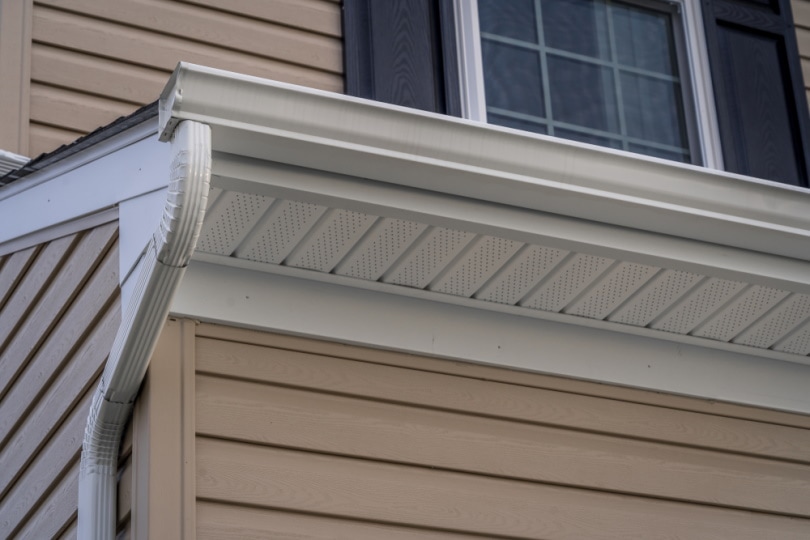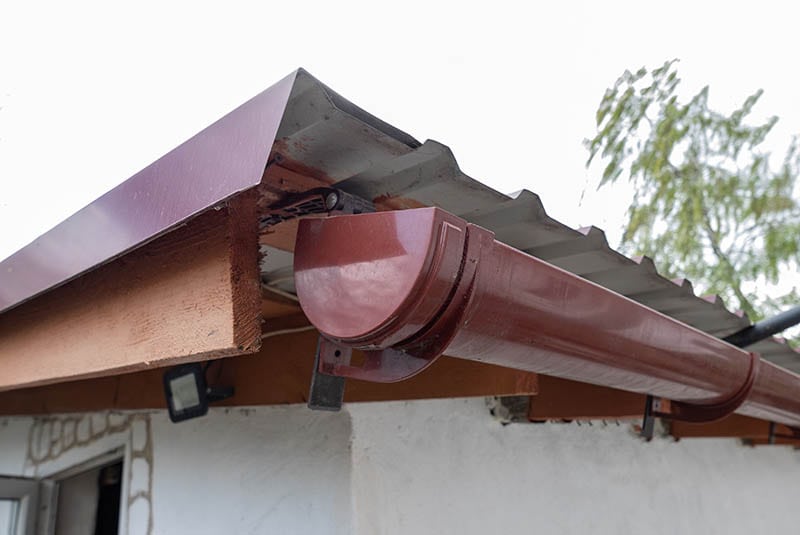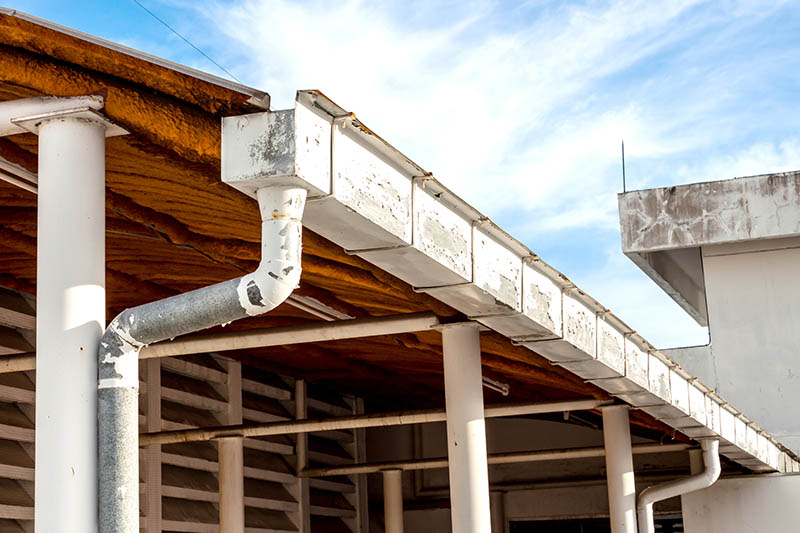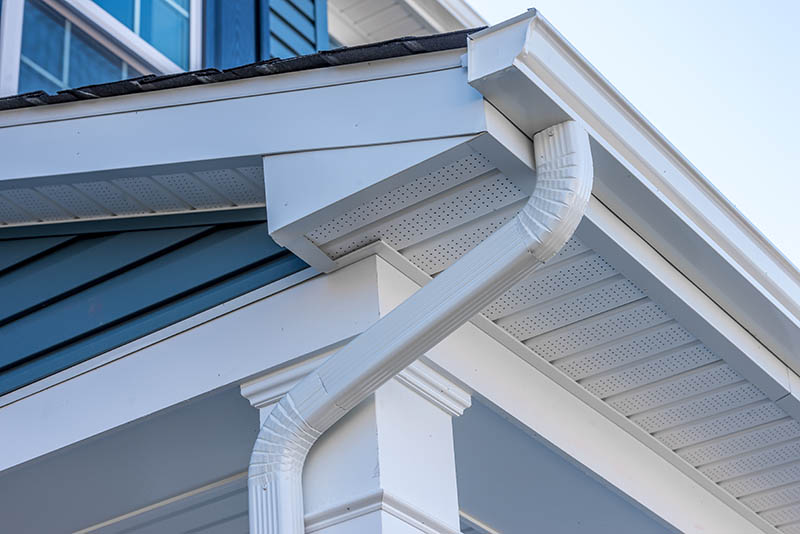4 Roof Gutter Types (With Pictures)
-

- Last updated:

If you are planning on upgrading, installing, or replacing your gutters, you might soon find yourself awash in options. There are various different styles and types of gutters to choose from. There are four styles of gutter and five common gutter materials that can be mixed and matched for a plethora of different options to fit your home and budget. Before making a decision about what type of gutter might be best for you, you need to know all of the options so you can make an informed decision.
Here are nine different types of roof gutters, including the pros and cons of each one.
The 4 Roof Gutter Types
1. Half Round

Half-round gutters are a style of gutter found on older homes. The half-round gutter was one of the first types of gutters to become widespread. These gutters resemble tubes that have been cut in half, hence the name. Half-round gutters provide a rustic look and a decent water catch rate. Half-round gutters typically come in 5” and 6” sizes.
The inside of half-round gutters is completely smooth, which means there are fewer places for water and debris to build up. That helps prevent corrosion and clogging over time. Half-round gutters are heavier and more expensive than the more modern K-style gutters. Since half-round gutters are fairly heavy to begin with, you have to be careful about what material you choose. Steel and copper half-rounds will be extremely heavy and difficult to maneuver.
- Rustic look found on old homes
- Good water catch rate
- Smooth interior is easy to clean and manage
- Heavier than other types of gutters
- More expensive than modern gutters
2. K-Style / K-Profile
K-style or K-profile gutters are the modern equivalent of the old half-round gutters. These gutters are the most common style found on newer homes and in new construction projects. K-style gutters get their name from their profile which looks like the letter K. These gutters provide a flat back, as opposed to the half-round, which has a rounded edge, making them easy to attach directly to an existing fascia board.
K-style gutters have an increased water catch rate and are rigid and durable, extremely affordable, and easy to install. All of these reasons make them popular with standard homeowners and do-it-yourselfers. The downside is that the flat back and seams provide more places for water and leaves to become trapped. The more water and debris inside the gutters, the more corrosion your gutters will suffer over time.
- Common and easy to install
- More modern look
- Great water catch rate
- Affordable
- More prone to clogging due to shape
- More likely to suffer from corrosion due to clogging and sitting water
3. Box

Box gutters are large gutters that are often found on commercial buildings. These heavy-duty gutter systems are integrated with the roofline and the shingles to form a seamless water-catching system. Box gutters must be installed when the roof is installed, so they are not popular with homeowners. Box gutters are designed to catch a large amount of water and are usually only installed on buildings featuring extremely large roofs. The larger the roof, or the steeper the pitch, the faster the flow of water will be into the gutters. Box gutters are designed to catch more water than the typical K-style gutter can handle.
Box gutters are expensive, require a specialist to install them, and they have to be installed when the roof is being replaced or installed for the first time. For these reasons, box gutters are rarely found on homes but are instead commonly found on large commercial buildings like grocery stores, strip malls, and warehouses.
- Extremely large
- Can deal with large roofs and lots of water
- Seamless system integrated with the roof
- Expensive
- Has to be installed with the roof
- Generally only for commercial spaces
4. Custom
In addition to these three types of gutter styles, there are also custom gutters. There are shops all around the country that will design special gutters to fit specific homes. These gutters can be created in a variety of different shapes that are different from the typical K-style or half-round. Custom gutters can be decorative or functional. Some old homes or historic homes might need special gutters built to match an existing aesthetic. Some homes feature curved bay window areas or unique rooflines that might require a custom touch.
Custom gutters are a lot more expensive than typical gutters, and they require more time and attention. Custom gutters can take weeks to have made and will usually require a professional to get them installed. However, they offer unrivaled customizability and style compared to typical gutters found at your average box store.
- Unique looks and designs
- Can be made to fit special houses or historic homes
- Lots of options and outcomes
- Very expensive
- Can take weeks or months to build and arrive
- Needs professional installation in most cases
Roof Gutter Materials
1. Aluminum

Aluminum gutters are the most common type of gutter on the market. They are lightweight and easy to install. They can hold up to a variety of different types of weather, including high heat and deep cold. Aluminum is also very affordable compared to other types of gutter materials. They can last up to 25 years or more with proper maintenance. You can also paint aluminum to match or accent your home’s exterior colors. These qualities make aluminum a great choice for gutter material, and it is extremely widespread as a result.
The only downside there is to aluminum is that it can be dented or scratched fairly easily. If you crash a ladder against it or have a tree branch strike it, it can crumple and become detached from your house.
- Weather resistant
- Lightweight and easy to install
- Affordable
- Can last up to 25 years
- Paintable
- Can be damaged if you are not careful
- Won’t last as long as more expensive materials
2. Zinc
Zinc is like an upgraded aluminum. Like aluminum, zinc will not rust, but it is also resistant to bending, scratching, dinging, or denting. Aluminum gutters can last 25 to 30 years, while zinc gutters can last over 50 years. Zinc is lightweight and very durable. Zinc gutters take all of the pros of aluminum gutters and enhance them for a longer-lasting product. If you are looking to install gutters once in your lifetime, zinc would be a great option.
The only downside to zinc is the cost. Zinc gutters cost quite a bit more than aluminum gutters (but not as much as copper gutters), but they offer more in the way of longevity and durability. Zinc is also a little trickier to install than aluminum since it is harder and more rigid.
- All of the benefits of aluminum but better
- Won’t rust
- Resistant to dings, scratches, and dents
- Can last over 50 years
- More expensive than aluminum
- Harder to install than aluminum or vinyl
3. Copper

Copper is an interesting gutter choice that can be used as a stylistic accent or a functional part of your home. Copper has some great benefits, including the fact that it will not rust. It is very durable, can hold up in direct sunlight, and can last for years. The Statue of Liberty is made of copper, and it has stood out in the elements for decades. New copper is also very shiny and has a great color that will accent certain home styles very well.
Copper gutters do have a few issues. First, they are very heavy and very expensive. Copper gutters will be levels of magnitude more expensive than aluminum or vinyl gutters. Copper will also patina over time which will slowly turn that gorgeous copper color into a dull green color. There is no way to prevent that. If you don’t mind the patina, the gutters can last a lifetime when installed properly.
- Can last a lifetime
- Stylish
- No rusting
- Doesn’t need paint
- Very expensive
- Very heavy
- Turns green over time
4. Vinyl

Vinyl is the cheapest type of material to build gutters out of. Vinyl gutters are lightweight and easy to cut, making them a favorite of homeowners looking to install the gutters themselves. Vinyl can also be painted. As opposed to metal, vinyl won’t rust or corrode due to exposure to water over time.
Vinyl’s biggest issue is its performance in tough weather. Vinyl fades really badly when exposed to direct sunlight, so it is often not a good choice for southern climates. Vinyl can also crack when exposed to hard freezes, so it is not great for far northern climates where water freezes in the gutters during the winter. Vinyl gutters are best for mild climates or shaded homes.
- Affordable
- Can be installed on your own
- Lightweight
- Paintable
- Fades and degrades in powerful sunlight
- Cracks during hard freezes
- Can be damaged by ladders or careless cleaning
5. Steel

Steel gutters are extremely durable. Unlike copper or aluminum gutters, they will not dent or scratch. They can take punishment from nearby tree branches and careless cleaners. Ladders won’t affect steel gutters, and they are built to last a long time.
Steel gutters have two main issues. First, steel is very heavy and dense, making installation a challenge for typical homeowners. Second, steel can rust over time. You can find stainless steel gutters that have better rust resistance, but regular galvanized steel could become rusty after years of use. Steel is a good middle ground between aluminum and zinc or copper gutters. They are cheaper than the latter two and more durable than aluminum (other than steel having the potential to rust).
- Very durable and heavy duty
- Can last many years with wear and tear
- Hard to damage or break
- Heavy and hard to install
- Can rust over time
Conclusion
Choosing between the different gutter styles and materials will be a personal decision based on the type of home you have and your budget. Some materials can last decades but will cost a lot of money. Other styles are very common and won’t stand out but will be affordable and easy to install. In the end, all of these gutter types work to complete one job – to whisk water off of your roof and away from your house – and they are all very good at that.
Featured Image Credit: tokar, Shutterstock
Contents

